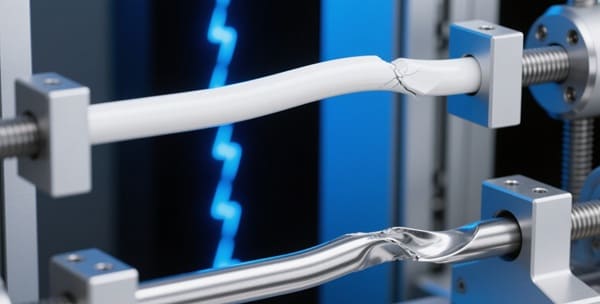Is Zirconia a Metal or Ceramic? The Science Behind This Advanced Material
Zirconia has become a cornerstone of modern material science, widely used in electronics, dentistry, aerospace, and fuel cells. However, many still wonder: Is zirconia a metal or a ceramic? This article will clarify the material’s scientific classification, explain its unique structure, and show how it compares to both metals and other ceramics in terms of performance, applications, and physical properties.
We’ll start with what zirconia is, how it behaves, and then compare its properties with metals and other ceramics. By the end, you’ll understand why zirconia’s unique identity makes it so valuable across industries.
At Advanced Ceramic Hub, we specialize in high-quality zirconia ceramic products, ensuring optimal performance for industrial and scientific applications.

What Is Zirconia and How Is It Classified?
Zirconia, chemically known as zirconium dioxide (ZrO₂), is an oxide ceramic known for its high strength and excellent thermal stability. It is derived from the metal zirconium but is not itself a metal. Zirconia exists in several crystalline forms and can be stabilized with additives like yttria (Y₂O₃) to improve its performance.
Its classification as a ceramic is based on its structure and properties: it is brittle, insulating, and formed through high-temperature sintering rather than melting and casting like metals.
Key Characteristics of Zirconia:
| Property | Description |
| Chemical formula | ZrO₂ |
| Crystal structure | Monoclinic, tetragonal, cubic (with dopants) |
| Electrical conductivity | Insulator at room temperature |
| Thermal conductivity | Low (2–3 W/m·K) |
| Mechanical behavior | Brittle, high hardness |
These characteristics clearly place zirconia in the category of technical ceramics, not metals. Its atomic bonding, electron behavior, and high-temperature sintering process all align with ceramic materials.
Explore our high-quality zirconia ceramic products.
How Does Zirconia Compare to Metals?
Though zirconia is derived from a metal, its properties are fundamentally different. Metals are generally ductile, conductive, and have metallic bonds, while zirconia has ionic/covalent bonds, making it non-metallic in behavior.
Zirconia’s comparison with metals reveals its unique strengths and limitations:
Zirconia vs. Metals:
| Feature | Zirconia | Typical Metal (e.g., Steel) |
| Electrical Conductivity | Very low (insulator) | High |
| Ductility | Brittle | Ductile |
| Density | Medium (5.68 g/cm³) | High (7.8 g/cm³ for steel) |
| Thermal Expansion | Low to moderate | High |
| Corrosion Resistance | Excellent | Moderate to good |
Zirconia is clearly not a metal based on performance, and its brittle nature alone disqualifies it from behaving like one. However, it can sometimes functionally replace metals where corrosion resistance or high-temperature stability is needed.
What Are the Advantages of Zirconia Over Other Ceramics?
Among ceramics, zirconia stands out for its toughness and wear resistance. Traditional ceramics like alumina or silicon carbide are brittle and hard but often crack under stress. Zirconia’s transformation-toughening mechanism allows it to resist fracture better.
Comparison of Technical Ceramics:
| Material | Hardness | Toughness | Max Temp (°C) | Electrical Behavior |
| Zirconia | High | High | ~2400 | Insulator |
| Alumina (Al₂O₃) | High | Medium | ~2050 | Insulator |
| Silicon Nitride | High | High | ~1900 | Semiconductor |
| Silicon Carbide | Very High | Low | ~2700 | Semiconductor |
Zirconia’s combination of hardness and fracture toughness gives it a practical edge in applications requiring mechanical shock resistance, such as cutting tools, dental implants, and structural supports.
Request a custom quote for zirconia ceramic products.
Is Zirconia a Metal-Like Ceramic?
Some engineers refer to zirconia as a “ceramic steel” due to its toughness. While zirconia is not metallic, it mimics some metal-like properties such as strength and density, making it suitable for structural or load-bearing applications.
“Metal-Like” Properties of Zirconia:
- High mechanical strength (~1000 MPa)
- Resistance to wear and impact
- Moderate density for ceramic
- Machinability in the pre-sintered state
These attributes let zirconia replace metals in some cases while offering ceramic benefits like corrosion resistance and thermal insulation.
Where Is Zirconia Used and Why?
Zirconia’s applications are driven by its superior thermal, mechanical, and chemical stability. From dental crowns to oxygen sensors, zirconia’s insulating properties and durability make it a material of choice.
Common Applications of Zirconia:
| Industry | Application | Reason for Use |
| Dental | Crowns, implants | Biocompatibility, strength |
| Electronics | Insulating components, oxygen sensors | Non-conductive, heat resistant |
| Aerospace | Thermal barrier coatings | Extreme temperature tolerance |
| Industrial | Pump seals, blades, bearings | Wear resistance, toughness |
These real-world uses reinforce zirconia’s identity as a ceramic, optimized through processing and doping rather than metallic behavior.
How Does Zirconia Compare with ZTA and YTZ Ceramics?
Engineers often face the choice between Zirconia, Zirconia Toughened Alumina (ZTA), and Yttria-stabilized Tetragonal Zirconia (YTZ). Each has strengths based on application needs.
Comparison: Al₂O₃ vs ZTA vs YTZ Ceramics
| Material | Composition | Toughness | Strength | Best Use |
| Al₂O₃ | Pure alumina | Medium | High | Electrical insulators, substrates |
| ZTA | Alumina + zirconia | High | Very High | Cutting tools, wear parts |
| YTZ | Yttria-stabilized zirconia | Very High | High | Dental, mechanical actuators |
While zirconia-based ceramics offer better toughness, alumina provides higher hardness and chemical stability. ZTA offers a balance and is suitable for high-stress environments.
Why Is Zirconia Frequently Mistaken for a Metal?
The confusion arises from zirconia’s high density, smooth surface finish, and strength, which give it a metal-like feel. However, chemically and structurally, it is an oxide ceramic.
Metal-Like Qualities That Cause Confusion:
- Shiny, polished appearance (especially in dental and jewelry use)
- High strength and load-bearing capacity
- High melting point (>2700°C)
- Compatibility with metallic-looking parts
Understanding the source (zirconium metal) also contributes to the misunderstanding. But the transformation from zirconium to zirconia involves full oxidation and structural changes that eliminate metallic behavior.
FAQ
| Question | Answer |
| Is zirconia a metal? | No, it’s a ceramic made from zirconium dioxide. |
| Why does zirconia look like metal? | Due to its dense, polished surface finish. |
| Is zirconia stronger than metal? | It can be in compressive strength, but not in ductility. |
| Can zirconia conduct electricity? | No, it’s an insulator at room temperature. |
| Is zirconia man-made or natural? | Mostly man-made through chemical processes. |
Conclusion
Zirconia is undoubtedly a ceramic, scientifically, structurally, and functionally. While it shares some visual and mechanical traits with metals, its electrical insulation, ionic bonding, and sintering production method confirm its ceramic identity. By understanding how zirconia compares with metals and other ceramics, including Al₂O₃, ZTA, and YTZ, industries can make informed material choices for demanding applications. In short, zirconia bridges the performance gap between traditional ceramics and metals, but remains firmly a ceramic in essence and application.
Looking for high-quality ceramic products? Contact us today!
